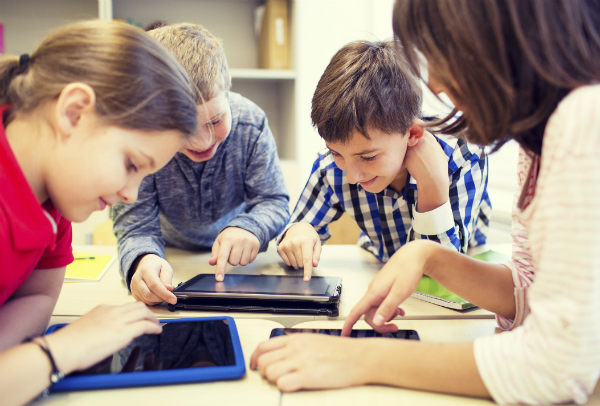GAME-BASED LEARNING
WHAT IS GAME-BASED LEARNING?
Game-based learning is a teaching method that uses the power of games to define and support learning outcomes. Or Game-based learning describes an approach to teaching, where students explore relevant aspects of games in a learning context designed by teachers. Game-based learning involves students using game development concepts and software to create their own games. Game-based activities are highly engaging and motivating for students and, when embedded (insert)within the curriculum, can be a highly effective way for students to learn.

What is the traditional mode of learning?
What is traditional learning? Traditional learning happens face-to-face in a classroom setting with one trainer and a group of learners. It’s fixed to a schedule. In a traditional environment, learners are taught theoretically. They are expected to apply the knowledge once they are out of the classroom. There is no way to make sure that the learners have grasped the concept well and will be able to apply it later. May not be able to inspire learners to be creative and think outside the box. They usually have a fixed structure.
At the same time, GBL encourages learners to break the mold and think differently. They do have a fixed set of rules, but the ground for innovation is far higher than traditional methods.

How does game-based learning work?:
Game-based learning takes this same concept and applies it to teaching a curriculum. Students work toward a goal, choosing actions and experiencing the consequences of those actions. They actively learn and practice the right way to do things. The result is active learning instead of passive learning
Determine the Purpose of Game-Based Learning:
Initially, teachers should determine the purpose of game-based learning and make sure it is aligned with learning goals. Lack of planning we can see many teachers struggle to smoothly incorporate games into lessons due to time and logistical issues. Before implementing GBL, determine you are included the following points use a game for:
Intervention- If a student is struggling to demonstrate understanding of core material, you may consider using a game to address his or her trouble spots. This should help the student gain a better understanding of difficult material.
Enrichment — As students master core material, you may want a game that presents content through different media. For example, it may give questions through text, audio, images, and more. This should encourage students to challenge themselves as they explore new ways to process the content.
Reinforcement — Instead of using games to teach and engage individual students, entire classes can play to reinforce curriculum content. This can also make game-based learning a group activity. Some games have multiplayer features and students may naturally compete against each other to earn higher scores.
Teacher Control — Many educational games offer teachers the ability to control content and adjust settings for individual students. For example, some let you match questions to in-class material, delivering them to specific players.
Intuitiveness -(awareness) Whether it’s a physical or video game, it should be easy to use. Students should challenge themselves by processing and demonstrating knowledge of the content — not by stressing over how the game works.
Content Levels — To address diverse trouble spots and aptitudes, the game should use differentiated instruction principles to adapt content to each player. For example, a language video game may focus more on pronouns with one student than another. Paying attention to these criteria while playing should help you decide if the game properly supports learning goals.
Content Types — To accommodate diverse learning styles, the game should offer different types of content. For example, If the topic is maths-related, may present numbers and word problems.
Engagement — Based on the content and how it’s presented, determine if students will enjoy the game. If it’s engaging, students should inherently want to play and, as a result, learn.
Some kinds of most common game-based learnings are:
-
Card games:- A game that uses a traditional or game-specific deck of cards. “War” is a traditional card game that can have a mathematical twist. Check out our list of classroom maths games to learn how to play.
-
Board games:-A game you play on a board that usually involves the movement of pieces. Chess and checkers are popular ones, but there are hundreds if not thousands of board games for kids to explore.
-
Simulation games:- Games are designed to closely simulate real-world activities. The Sims, which launched in 2000, is one of the most popular series of life simulation games that involves creating and exploring virtual worlds.
-
Word games:- A game that’s typically designed to explore the properties of language or the ability to use a language itself. Scrabble is an example of a traditional word game while the app Words With Friends is a more modern one.
-
Puzzle games:- A game that emphasizes puzzle-solving through one’s use of things such as logic, word completion, sequence solving, as well as spatial and pattern recognition. For example, Sudoku and magic square are popular math puzzles.
-
Video games:- An electronic game wherein players can manipulate what appears on the screen with, for example, a joystick, controller, or keyboard. A couple that might pop into your head is the decades-old classic Pac-Man, or, more recently, Fortnite.
-
Role-playing games:- A game in which players assume the role of imaginary characters who engage in adventures. A popular fantasy tabletop RPG is Dungeons & Dragons and was first introduced in 1974. Prodigy Math Games is also a massively multiplayer online role-playing game (MMORPG) where 1st to 8th-grade students go on exciting adventures and correctly answer curriculum-aligned math questions to progress.
-
In a classroom with limited device use, make time for game-based learning activities by:
* Focusing more on non-digital games, such as board games with educational value.
* Creating learning stations, one of which is playing a device-based game.
*Playing team games, letting students play in pairs or groups.
* Playing puzzles, who am I game? guessing games by giving clues. Make sure all would be subject-related.
Top benefits of game-based learning
Some educators and researchers still argue that game-based learning can be detrimental to the educational experience. However, studies continue to show that games can positively impact things like students’ math and language learning in many ways. Game-based learning.
Helps problem-solving– Game-based learning can help students solve problems by fostering skills like understanding causation, logic, and decision making they can use in life outside of school.
Encourages critical thinking-GBL can improve students’ critical thinking skills, “including the development of independent beliefs. Prior to engaging in collaborative discourse and providing opportunities for guided reflection.”
Increases student engagement and motivation – when teachers incorporate digital game-based learning elements such as feedback, choice, and collaboration into their instructional design, students become more engaged and motivated to learn.
Introduces situational learning – Learning doesn’t only occur in our heads; it, in fact, it’s a fundamentally social process.
Addresses special education needs– GBL positively impacts special education classrooms “game-based learning is a must to help guide instruction, create a positive environment, and generate academic success. And students with autism are more successful and motivated when using computerized games for academic lessons.”
Improvement of Teamwork and Interpersonal Skills Successful completion of a problem-based learning challenge hinges on interaction and communication, meaning students should also build transferable skills based on teamwork and collaboration. Instead of memorizing facts, they get chances to present their ideas to a group, defending and revising them when needed. What’s more, this should help them understand a group dynamic.

Drawbacks of game-based learning
As we mentioned above, not everyone is convinced of game-based learning just yet. GBL’s purpose was never to replace teachers and traditional learning, but to help positively augment it. Depending on your personal teaching approaches or a student’s individual learning style, there can be drawbacks to game-based learning:
-
Too much screen time
-
Games aren’t always created equally
-
Games can be a source of distraction
-
It requires a technology learning curve
-
Doesn’t replace traditional learning strategies
-
Not always aligned to teaching or learning goals
Researchers still have much to study about GBL and, if not implemented effectively, teachers and students can have a poor experience.
However, we hope resources such as the one you’re reading now help empower educators and students alike to benefit from game-based learning — in school and beyond!
Vasantha. K.P




